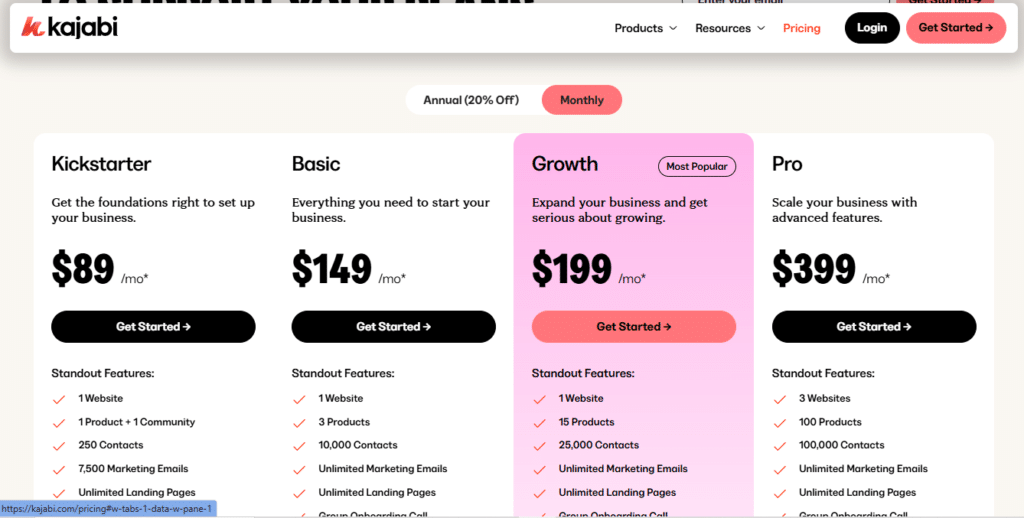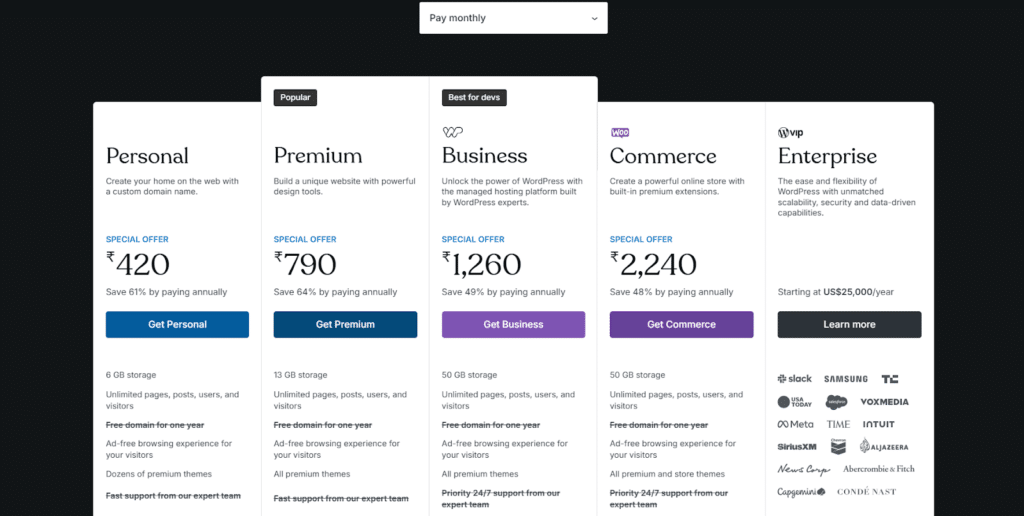Kajabi vs WordPress: A Comprehensive Platform Comparison
When it comes to building an online presence, Kajabi and WordPress stand out as two powerful but vastly different platforms.
Kajabi is an all-in-one solution designed specifically for digital entrepreneurs, offering built-in tools for course creation, email marketing, and sales automation. WordPress, on the other hand, is a highly customizable content management system that powers over 40% of the web, giving users complete control over design, functionality, and scalability.
The choice between Kajabi and WordPress depends on your business needs, technical expertise, and long-term goals. Are you looking for a plug-and-play system with everything integrated, or do you prefer the flexibility of customizing your own website with plugins and third-party tools?
In this comparison, we’ll break down their key differences, strengths, and potential drawbacks to help you decide which platform is best suited for your online business.
Overview of Kajabi

Kajabi is an all-in-one platform designed for entrepreneurs, educators, and digital creators looking to launch and scale their online businesses with ease. It provides a seamless ecosystem for creating, marketing, and selling digital products such as online courses, memberships, and coaching programs—all without relying on multiple third-party tools.
With its built-in website builder, email marketing automation, and sales pipeline creation, Kajabi simplifies the process of running a digital business. Even users with minimal technical knowledge can easily create high-quality content using pre-built templates and intuitive drag-and-drop functionality. By integrating powerful marketing tools with a robust learning management system (LMS), Kajabi enables businesses to efficiently attract, engage, and convert their audience while maximizing revenue—all from a single, user-friendly dashboard.
Key Features of Kajabi
- Course Creation Tools: Develop and deliver engaging online courses with video content, assessments, and drip-fed lessons.
- Website Builder: Design fully responsive, professional websites with built-in blogging capabilities and customizable templates.
- Sales Pipelines: Create automated funnels for lead generation, product launches, and webinars.
- Email Marketing Automation: Send personalized email campaigns, track engagement, and automate follow-ups.
- Membership Capabilities: Set up subscription-based memberships to generate recurring revenue.
- Payment Integration: Securely accept payments via Stripe and PayPal with zero additional transaction fees.
- Analytics Dashboard: Monitor revenue, track customer behavior, and measure marketing performance with in-depth insights.
- Community Features: Build an interactive member space for discussions, engagement, and networking.
Ideal User Base for Kajabi
- Course Creators: Educators and professionals looking to monetize their knowledge through online courses.
- Coaches & Consultants: Those offering coaching services, webinars, and one-on-one mentorship programs.
- Membership Site Owners: Entrepreneurs looking to create thriving subscription-based communities.
- Digital Entrepreneurs: Individuals managing multiple digital products and looking for a streamlined business solution.
Overview of WordPress

WordPress is the world’s most popular content management system (CMS), offering unmatched flexibility and control for building websites, blogs, and eCommerce stores. Unlike Kajabi, which provides an all-in-one solution, WordPress serves as a highly customizable platform that requires additional plugins and third-party integrations to achieve similar functionalities.
With thousands of themes and plugins, WordPress allows users to tailor their websites to their exact needs—whether they’re creating an online course, selling digital products, or running a full-scale online business. However, managing a WordPress site requires a certain level of technical knowledge, as users must handle hosting, security, plugin updates, and website optimization independently.
Despite the steeper learning curve, WordPress remains the preferred choice for businesses that need complete creative freedom and scalability.
Key Features of WordPress
- Website & Blog Builder: Fully customizable websites with thousands of free and premium themes.
- Plugins & Integrations: Extend functionality with over 50,000 plugins for SEO, eCommerce, course creation, and more.
- E-Commerce with WooCommerce: Sell digital and physical products with flexible payment options.
- SEO Optimization: Use powerful SEO plugins like Yoast SEO to improve search engine rankings.
- Content Management System: Easily create and manage blog posts, pages, and multimedia content.
- User Role Management: Assign different access levels for contributors, editors, and administrators.
- Hosting & Security: Choose from various hosting providers and install security plugins for site protection.
- Scalability: Ideal for businesses looking to expand their website’s functionality over time.
Ideal User Base for WordPress
- Bloggers & Content Creators: Writers and media creators who want complete control over their content and SEO.
- Small to Large Businesses: Companies looking for a fully customizable website solution.
- E-Commerce Entrepreneurs: Businesses selling products online using WooCommerce or other eCommerce integrations.
- Tech-Savvy Users: Individuals comfortable with managing hosting, plugins, and security updates.
- Developers & Designers: Professionals who need an open-source platform for building custom client websites.
Both Kajabi and WordPress offer powerful solutions, but the right choice depends on your business model, technical expertise, and long-term goals. In the next sections, we’ll compare their ease of use, customization, pricing, and overall value to help you determine which platform best suits your needs.
Core Functionalities Comparison: Kajabi vs. WordPress
Choosing the right platform for your online business depends on the features and functionalities that align with your goals. While Kajabi offers an all-in-one solution for digital entrepreneurs, WordPress provides unmatched customization and flexibility. In this section, we’ll compare the core functionalities of both platforms to help you determine which one best suits your needs.
1. Website Building & Customization
Kajabi provides an intuitive drag-and-drop website builder with pre-designed templates, making it easy for users to create professional websites without coding. The platform includes built-in blogging capabilities, landing pages, and a centralized dashboard to manage everything in one place. While customization options are available, they are limited compared to WordPress.
WordPress offers extensive flexibility in website building. Users can choose from thousands of themes and install page builders like Elementor or Divi for drag-and-drop functionality. Developers can customize their websites at the code level, providing complete creative freedom. However, users must manage hosting, security, and updates separately.
2. Course Creation & Memberships
Kajabi is built specifically for online course creators. It includes a Learning Management System (LMS) that allows users to structure courses, upload multimedia content, set up drip schedules, and offer quizzes and certifications. Membership features are also included, making it easy to create subscription-based communities.
WordPress does not come with course creation features by default but can be extended with LMS plugins like LearnDash, LifterLMS, or TutorLMS. Similarly, membership plugins like MemberPress or Restrict Content Pro enable users to monetize gated content. While this setup allows for more customization, it requires managing multiple plugins and ensuring compatibility.
3. Sales Funnels & Marketing Automation
Kajabi offers built-in sales funnels (Pipelines) that help users automate lead generation, webinars, and product launches. Its integrated email marketing system enables users to create automated email sequences, track engagement, and personalize communication without needing third-party software.
WordPress does not have built-in sales funnel tools, but users can integrate plugins like CartFlows, OptimizePress, or ClickFunnels to build conversion-optimized pages. For email marketing, users must rely on services like Mailchimp, ConvertKit, or ActiveCampaign. This approach offers flexibility but requires more setup.
4. E-Commerce & Payment Processing
Kajabi is designed for selling digital products, courses, and memberships. It includes built-in payment processing through Stripe and PayPal with no extra transaction fees. However, it is primarily focused on digital sales and does not support selling physical products.
WordPress, when combined with WooCommerce, is a complete e-commerce solution. It enables users to sell both physical and digital products, manage inventory, handle shipping, and accept multiple payment gateways. WooCommerce is free, but some advanced features require paid extensions.
5. SEO & Blogging Capabilities
Kajabi offers basic SEO settings, such as meta tags, URLs, and keyword optimization for blogs and course pages. However, its blogging capabilities are more limited compared to dedicated blogging platforms.
WordPress is well-known for its robust blogging and SEO capabilities. With plugins like Yoast SEO or Rank Math, users can optimize content, implement schema markup, and improve search rankings. The ability to structure content using categories, tags, and custom post types gives WordPress an edge for content-driven businesses.
6. Integrations & Third-Party Tools
Kajabi includes native integrations with popular tools like Stripe, PayPal, Zapier, ConvertKit, and ActiveCampaign. While these cover essential business needs, Kajabi has fewer integration options compared to WordPress.
WordPress supports thousands of integrations through plugins and APIs, allowing users to connect with almost any external tool, including CRMs, analytics platforms, and advanced marketing software. However, managing multiple integrations may require additional setup and maintenance.
Both Kajabi and WordPress are powerful platforms, but their core functionalities cater to different needs.
Kajabi simplifies the process with built-in tools for course creation, marketing, and automation, making it an excellent choice for entrepreneurs who want an all-in-one solution.
WordPress, on the other hand, offers greater flexibility, customization, and control, making it ideal for users who require advanced features and don’t mind managing multiple plugins and integrations.
Pricing Comparison: Kajabi vs Mighty Networks
Here’s how Kajabi and Mighty Networks compare in pricing:
Kajabi Pricing Plans

Kajabi offers a variety of pricing plans tailored to creators and businesses at different stages of growth. Here’s an overview of Kajabi’s pricing structure:
1. Basic Plan ($149/month)
The Basic Plan is ideal for newcomers to online business. It includes essential tools to get started, such as:
- Support for 3 products and 3 pipelines.
- 10,000 contacts and 1,000 active members.
- Basic marketing automation.
- Unlimited landing pages and emails.
2. Growth Plan ($199/month)
The Growth Plan is perfect for scaling businesses that require advanced marketing features and greater resource limits:
- Support for 15 products and 15 pipelines.
- 25,000 contacts and 10,000 active members.
- Advanced automation and affiliate program management.
- Removal of Kajabi branding for a more customized experience.
3. Pro Plan ($399/month)
The Pro Plan is designed for established businesses with high-volume requirements:
- Support for 100 products and 100 pipelines.
- 100,000 contacts and 20,000 active members.
- Priority support and custom branding capabilities.
- Advanced features such as code editor access for deeper customization.
4. Kickstarter Plan ($89/month)
This budget-friendly option is ideal for beginners who want to test Kajabi’s core functionalities before committing to higher-tier plans:
- Limited products and pipelines.
- Basic features for course creation and email marketing.
Kajabi’s pricing is flexible and based on the number of products, contacts, and features you need. While the cost is higher than many competitors, its all-in-one functionality provides immense value for creators looking to manage their entire business from a single platform. Additionally, Kajabi does not charge transaction fees, which ensures that you retain more of your revenue.
WordPress: Tiered Pricing for Comprehensive Digital Product Creation
WordPress.com offers several tiers to suit different needs:

The Free Plan includes basic features with a WordPress.com subdomain.
The Personal Plan at $4 per month (billed annually) includes:
- Custom domain name
- Remove WordPress.com ads
- Access to premium themes
- Email and live chat support
The Premium Plan at $8 per month (billed annually) adds:
- Advanced design customization
- Monetization tools
- Google Analytics integration
- VideoPress support
The Business Plan at $25 per month (billed annually) includes:
- Plugin and theme installations
- SEO tools
- Advanced marketing tools
- Custom CSS editing
The Commerce Plan at $45 per month (billed annually) adds:
- eCommerce features
- Premium store customization
- Integrated shipping tools
- Accept payments in 60+ countries
All paid plans include:
- Free domain for first year
- Hosting and security features
- Access to premium themes
- Email and chat support
When it comes to pricing, Kajabi offers a clear, all-inclusive structure without hidden costs, covering hosting, marketing, and course creation in one platform. In contrast, WordPress requires multiple paid plugins, hosting, and third-party tools, which can quickly add up. For those seeking simplicity and value, Kajabi’s pricing is the more predictable and cost-effective option.
Making the Right Choice For Your Business
Choosing between Kajabi and WordPress depends on your business needs and technical expertise. Kajabi offers an all-in-one, user-friendly solution designed for course creators, coaches, and membership businesses, eliminating the need for third-party tools. It streamlines website building, marketing, and sales, making it ideal for entrepreneurs looking for simplicity and efficiency.
WordPress, on the other hand, provides unmatched flexibility and customization, making it a powerful choice for those who want full control over their website. However, it requires plugins, maintenance, and technical know-how. If you prefer an integrated, hassle-free platform, Kajabi is a strong contender, while WordPress is better suited for those comfortable with customization and ongoing management.